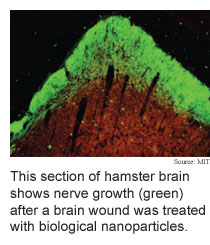
March
13/20, 2006
Nano
knitting mends brains
Scientists have used a nanotechnology-based technique to repair
traumatic brain injuries in hamsters. The brain injuries blinded the animals;
the repair partially restored the hamsters' vision.
 The researchers, from the Massachusetts Institute of Technology,
Hong Kong University, and the Fourth Military Medical University in China,
have found
a way to make peptide molecules self-assemble into nanofiber scaffolding
that can then guide the growth of regenerating nerve cells at the site
of a wound.
The researchers, from the Massachusetts Institute of Technology,
Hong Kong University, and the Fourth Military Medical University in China,
have found
a way to make peptide molecules self-assemble into nanofiber scaffolding
that can then guide the growth of regenerating nerve cells at the site
of a wound.
The researchers tested the technique by injecting the self-assembling
peptide scaffolds into knife wounds inflicted in hamster brains.
The technique overcomes several major hurdles to nerve cell regeneration.
The nanofibers blocked the formation of scar tissue, broke down into amino
acids that are either excreted or used by the body, and did not trigger
nerve tissue rejection. All of the animals that received the treatment
showed nerve cell growth across the wound, and six out of eight showed
signs of restored vision.
The technique has the potential to significantly improve the treatment
of brain and spinal cord injuries.
(Nano Neuro Knitting: Peptide Nanofiber Scaffold for Brain Repair
and Axon Regeneration with Functional Return of Vision, Proceedings
of the National Academy Of Sciences, March 13, 2006)
Mighty molecular motor
Scientists have made several types of single-molecule rotary motors.
The challenge is getting them to do useful work.
Researchers from the University of Groningen, Eindhoven University
of Technology and Philips Research Laboratories, all in the Netherlands,
have developed a rotor
molecule that can rotate a microscopic glass rod. The molecular motor
is driven by a combination of ultraviolet light and heat.
When dispersed at a concentration of one percent in a liquid crystal
film, the molecule's motion rotates patterns in the liquid crystal's surface
texture. This in turn can spin a 28-micron-long, 5-micron-wide glass rod
in about 10 minutes.
Molecular motors will be needed to power nanoscale devices, including
those that open hatches on microscopic capsules for delivering drugs inside
the body.
(Nanomotor Rotates Microscale Objects, Nature, March 9,
2006)
Bits and pieces
Broken straw illusion
A ray tracing graphics
simulation of left-handed materials shows that if a straw were placed
in a glass of fictional liquid that had a negative index of refraction
the straw would appear to be broken rather than appearing to bend at the
air-liquid line. Scientists have recently made solid materials that have
negative indices of refraction; these unusual optical properties could
make flat lenses that focus light like ordinary curved lenses.
(Photorealistic Images of Objects in Effective Negative-Index
Materials, Optics Express, March 6, 2006)
Precision positioning with DNA
A combination of self-assembled networks
of DNA and protein molecules and protein molecules that can address
the network at the molecular level makes it possible to build nanodevices
molecule-by-molecule and to precisely place molecules into arrays for
biomedical testing.
(Macroscopic 2D Networks Self-Assembled from Nanometer-Sized Protein/DNA
Complexes, Nano Letters, March 8, 2006)
Nano metronome
A nanoscale
metronome identifies DNA strands at the level of individual base pairs.
The four-arm DNA molecule rapidly switches back and forth between shapes,
changing speed when specific strands of DNA attach to two of the arms.
It could be used to identify DNA strands that differ by as little as a
single base pair.
(Single Molecule Nanometronome, Nano Letters, March 8,
2006)
Printing nanocircuits
A nanoscale printing
process forms memory that holds as much as 100 gigabits per square
centimeter -- 12 times the density of today's flash memory chips.
(Circuit Fabrication at 17 nm Half-Pitch by Nanoimprint Lithography,
Nano Letters, March 8, 2006)
RSS Feeds: News Blog Books New: TRN's Internet Services TRN's Jobs Center News: Research News Roundup Research Watch blog Features: View from the High Ground Q&A How It Works Buy an ad link |
|
| Advertisements: |
|
Ad links: Clear History
Buy an ad link
|
TRN
Newswire and Headline Feeds for Web sites
|